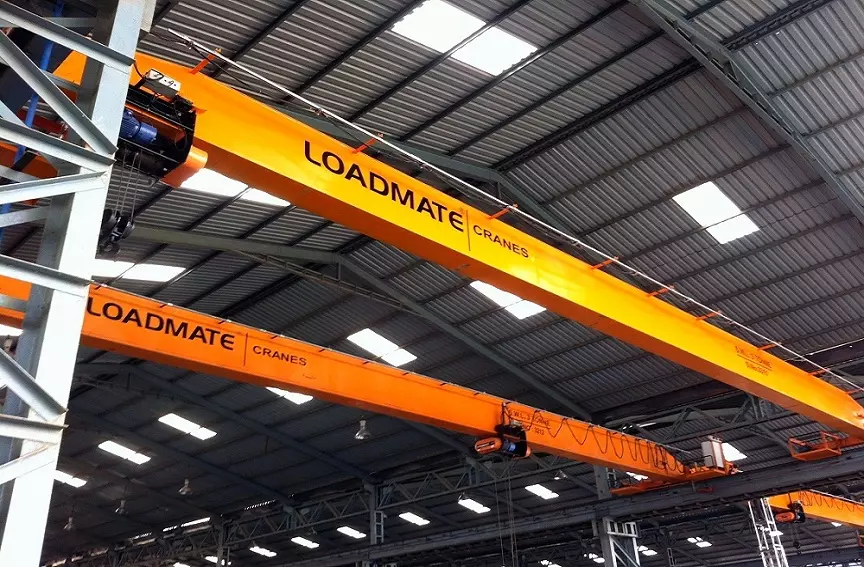Bridge Electric Overhead Travelling (EOT) Cranes, also known as Overhead EOT Cranes, Industrial Crane, or Overhead Travelling Cranes, are indispensable tools in the modern industrial landscape. These cranes play a pivotal role in the movement and transportation of heavy materials vertically and horizontally across different environments, such as warehouses, fabrication shops, shipping ports, and railway stations. Understanding the intricacies of a Bridge EOT Crane is essential for optimising its functionality and ensuring safety in the workplace.
Anatomy of a Bridge EOT Crane
A Bridge EOT Crane consists of Four primary components:
- Crane Bridge: This is a single or double girder structure that travels along the runway. The bridge can be designed as a box or beam girder, each with its own set of advantages.
- Hoist and Trolley: The hoist is the mechanism responsible for lifting and lowering the load, while the trolley enables the hoist to move horizontally across the bridge.
- Runway: This is the supporting structure that defines the area where the crane can operate. It can be either tied to the building structure or freestanding, and its design involves critical engineering considerations.
- End Trucks: Also referred to as End Carriages, these are legs of the Crane. The Girder(s) rests on these end trucks. These End Trucks carry the Crane Bridge on the Runway Track.
Types of Bridge EOT Cranes
Bridge EOT Cranes come in two primary configurations: Top Running Bridge Cranes and Under Running Bridge Cranes.
- Top Running Bridge Cranes: In this configuration, the bridge travels on top of rails mounted on a runway beam supported by either specially designed columns or the building's existing columns. This design minimises headroom requirements while maximising the height of lift, making it suitable for handling heavier loads.
- Under Running Bridge Cranes: Also known as under-hung or underslung cranes, these cranes have end trucks that ride on the bottom flange of the runway, typically suspended from the roof. This design eliminates the need for additional columns to support the runway, saving floor space and costs.
Key Factors to Consider in Bridge EOT Crane Design
- Design of Bridge: The bridge can be either top running or underslung, each with its own set of advantages. A top-running bridge can handle heavier loads, while an underslung bridge is more flexible in transferring loads and interfacing with monorail systems.
- Load Capacity: The maximum load capacity of the bridge must be clearly labelled on both sides of the crane. If an overload protection device is installed, a load test is mandatory to ensure safety.
- Girder Type: The crane can be classified into Single Girder Cranes and Double Girder Cranes based on the girder type.
-
- Single Girder Crane: This design consists of a trolley hoist unit, two end trucks, and a single bridge girder. It is cost-effective and suitable for lighter loads and shorter spans.
- Double Girder Crane: This design includes two bridge girders, two end trucks, and a trolley hoist unit. It provides higher hook heights and is ideal for handling heavier loads and longer spans.
Conclusion
Bridge EOT Cranes are essential tools in various industrial applications, from material storage and fabrication to loading and unloading operations in yards, facilities, and transportation hubs. Understanding the different components, configurations, and key factors in the design of a Bridge EOT Crane is crucial for optimising its functionality and ensuring safety in the workplace.
Remember to consider the design of the bridge, load capacity, and girder type when selecting or designing a Bridge EOT Crane for your application. By making informed decisions, you can enhance operational efficiency, ensure safety, and ultimately contribute to the success of your business.
Bridge Electric Overhead Travelling (EOT) Cranes, also known as Overhead EOT Cranes, Industrial Crane, or Overhead Travelling Cranes, are indispensable tools in the modern industrial landscape. These cranes play a pivotal role in the movement and transportation of heavy materials vertically and horizontally across different environments, such as warehouses, fabrication shops, shipping ports, and railway stations. Understanding the intricacies of a Bridge EOT Crane is essential for optimising its functionality and ensuring safety in the workplace.
Anatomy of a Bridge EOT Crane
A Bridge EOT Crane consists of Four primary components:
- Crane Bridge: This is a single or double girder structure that travels along the runway. The bridge can be designed as a box or beam girder, each with its own set of advantages.
- Hoist and Trolley: The hoist is the mechanism responsible for lifting and lowering the load, while the trolley enables the hoist to move horizontally across the bridge.
- Runway: This is the supporting structure that defines the area where the crane can operate. It can be either tied to the building structure or freestanding, and its design involves critical engineering considerations.
- End Trucks: Also referred to as End Carriages, these are legs of the Crane. The Girder(s) rests on these end trucks. These End Trucks carry the Crane Bridge on the Runway Track.
Types of Bridge EOT Cranes
Bridge EOT Cranes come in two primary configurations: Top Running Bridge Cranes and Under Running Bridge Cranes.
- Top Running Bridge Cranes: In this configuration, the bridge travels on top of rails mounted on a runway beam supported by either specially designed columns or the building's existing columns. This design minimises headroom requirements while maximising the height of lift, making it suitable for handling heavier loads.
- Under Running Bridge Cranes: Also known as under-hung or underslung cranes, these cranes have end trucks that ride on the bottom flange of the runway, typically suspended from the roof. This design eliminates the need for additional columns to support the runway, saving floor space and costs.
Key Factors to Consider in Bridge EOT Crane Design
- Design of Bridge: The bridge can be either top running or underslung, each with its own set of advantages. A top-running bridge can handle heavier loads, while an underslung bridge is more flexible in transferring loads and interfacing with monorail systems.
- Load Capacity: The maximum load capacity of the bridge must be clearly labelled on both sides of the crane. If an overload protection device is installed, a load test is mandatory to ensure safety.
- Girder Type: The crane can be classified into Single Girder Cranesand Double Girder Cranes based on the girder type.
-
- Single Girder Crane: This design consists of a trolley hoist unit, two end trucks, and a single bridge girder. It is cost-effective and suitable for lighter loads and shorter spans.
- Double Girder Crane: This design includes two bridge girders, two end trucks, and a trolley hoist unit. It provides higher hook heights and is ideal for handling heavier loads and longer spans.
Conclusion
Bridge EOT Cranes are essential tools in various industrial applications, from material storage and fabrication to loading and unloading operations in yards, facilities, and transportation hubs. Understanding the different components, configurations, and key factors in the design of a Bridge EOT Crane is crucial for optimising its functionality and ensuring safety in the workplace.
Remember to consider the design of the bridge, load capacity, and girder type when selecting or designing a Bridge EOT Crane for your application. By making informed decisions, you can enhance operational efficiency, ensure safety, and ultimately contribute to the success of your business.




